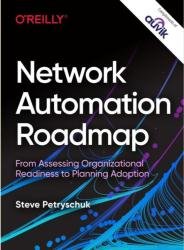 Название: Network Automation Roadmap: From Assessing Organizational Readiness to Planning Adoption
Название: Network Automation Roadmap: From Assessing Organizational Readiness to Planning AdoptionАвтор: Steve Petryschuk
Издательство: O’Reilly Media, Inc.
Год: 2021
Язык: английский
Формат: epub
Размер: 10.2 MB
With its vast array of open source resources, scripting, and coding options, network automation can be daunting for IT pros in organizations of all sizes. This report examines business and technology trends in network automation today and delves into practical considerations for teams in small organizations looking to implement or improve automation practices.
Today’s computers, from modern mainframes and hyperconverged infrastructure to smartphones and Internet of Things (IoT) devices, would be almost useless without networks to connect them. Many network components—from routers, switches, and access points to the software that implements virtual private networks (VPNs) and software-defined wide area network (SD-WAN) topologies—are complex mechanisms that, at least from the user’s perspective, should “just work” all the time, no matter how loads and user needs change. Theoretically, the best possible performance of a network may be obtained with a manually optimized configuration of all of the network’s elements that takes into full account all the components, users, and application usage, along with changes in use of each of these. While this would lead to a perfectly optimized network, working in this way would consume too much time, require so much expertise, and likely still produce enough errors to cause network downtime—after all, there is still room for human error.
Relying on manual network optimization becomes unsustainable in the long run for every organization counting more than a few users or devices under management. In all but the simplest and most stable networks, almost every low-level, manual configuration or maintenance of your network devices represents time and money that could, and really should, be spent somewhere else.
The obvious solution to the problems presented by manual network optimization is network automation, which can occur in several areas. Throughout this report, we will explore these areas of automation available to IT teams and discuss a path toward automating various tasks that today are done manually. If we were to think about each area of tasks that we can automate as distinct “buckets of automation,” we could then measure to which degree we automate each bucket. It is important to recognize that some organizations will never need to go to the maximum degree, or maximum automation, in each area. Other organizations may find that different departments or different network segments may experience different degrees of automation as time goes on.
Скачать Network Automation Roadmap